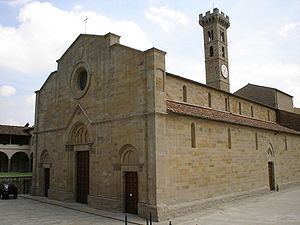Parishes 218 | Established 1st Century Area 1,300 km² | |
 | ||
Population- Total- Catholics (as of 2006)140,900138,900 (98.6%) | ||
The Diocese of Fiesole (Latin: Dioecesis Fesulanus) is a Roman Catholic diocese in Tuscany, central Italy, whose episcopal see is the city of Fiesole. It is a suffragan of the Metropolitan Archbishopric of Florence.
Contents
History
According to local legend the Gospel was first preached at Fiesole by St. Romulus, a disciple of St. Peter. The fact that the ancient cathedral (now the Abbazia Fiesolana) stands outside the city is an indication that the Christian origins of Fiesole date from the period of the persecutions. The earliest mention of a bishop of Fiesole is in a letter of Pope Gelasius I (492-496). A little later, under Vigilius (537-555), a Bishop Rusticus is mentioned as papal legate at one of the councils of Constantinople. The legendary St. Alexander is said by some to belong to the time of the Lombard King Autari (end of the sixth century), but the Bollandists assign him to the reign of Lothair I (middle of the ninth century).
A prominent bishop was St. Donatus, an Irish monk, the friend and adviser of Emperors Louis the Pious and Lothair I. He was elected in 826 and is buried in Fiesole Cathedral, where his epitaph, which he dictated personally, may still be seen. He founded the abbey of San Martino di Mensola. Bishop Zanobi in 890 founded that of St. Michael at Passignano, which was afterwards given to the Vallombrosan monks. Other bishops were Atinolfo (1038), who opposed papal reform; Hildebrand of Lucca (1220), exiled by the Florentines; and St. Andrew Corsini (1352), born in 1302 of a noble Florentine family, who, after a reckless youth, became a Carmelite friar, studied at Paris, and who, as a bishop, was renowned as a peacemaker between individuals and states. He was canonized by Urban VIII.
Statistics
In the early 20th century, according to the Catholic Encyclopedia, the diocese had 254 parishes and 155,800 people. Within its limits there were 12 monasteries of men, including the famous Vallombrosa, and 24 convents for women.
